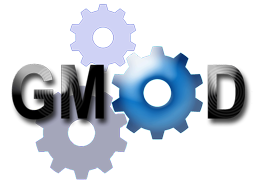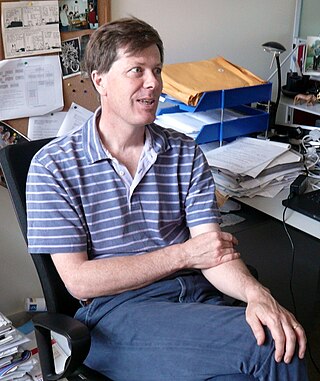In information science, an ontology encompasses a representation, formal naming, and definitions of the categories, properties, and relations between the concepts, data, or entities that pertain to one, many, or all domains of discourse. More simply, an ontology is a way of showing the properties of a subject area and how they are related, by defining a set of terms and relational expressions that represent the entities in that subject area. The field which studies ontologies so conceived is sometimes referred to as applied ontology.
The Gene Ontology (GO) is a major bioinformatics initiative to unify the representation of gene and gene product attributes across all species. More specifically, the project aims to: 1) maintain and develop its controlled vocabulary of gene and gene product attributes; 2) annotate genes and gene products, and assimilate and disseminate annotation data; and 3) provide tools for easy access to all aspects of the data provided by the project, and to enable functional interpretation of experimental data using the GO, for example via enrichment analysis. GO is part of a larger classification effort, the Open Biomedical Ontologies, being one of the Initial Candidate Members of the OBO Foundry.

Michael Ashburner was an English biologist and Professor in the Department of Genetics at University of Cambridge. He was also the former joint-head and co-founder of the European Bioinformatics Institute (EBI) of the European Molecular Biology Laboratory (EMBL) and a Fellow of Churchill College, Cambridge.
The Open Biological and Biomedical Ontologies (OBO) Foundry is a group of people dedicated to build and maintain ontologies related to the life sciences. The OBO Foundry establishes a set of principles for ontology development for creating a suite of interoperable reference ontologies in the biomedical domain. Currently, there are more than a hundred ontologies that follow the OBO Foundry principles.

The Generic Model Organism Database (GMOD) project provides biological research communities with a toolkit of open-source software components for visualizing, annotating, managing, and storing biological data. The GMOD project is funded by the United States National Institutes of Health, National Science Foundation and the USDA Agricultural Research Service.

Probable G-protein coupled receptor 110 is a protein that in humans is encoded by the GPR110 gene. This gene encodes a member of the adhesion-GPCR receptor family. Family members are characterized by an extended extracellular region with a variable number of N-terminal protein modules coupled to a TM7 region via a domain known as the GPCR-Autoproteolysis INducing (GAIN) domain.
Gerald Mayer Rubin is an American biologist, notable for pioneering the use of transposable P elements in genetics, and for leading the public project to sequence the Drosophila melanogaster genome. Related to his genomics work, Rubin's lab is notable for development of genetic and genomics tools and studies of signal transduction and gene regulation. Rubin also serves as a vice president of the Howard Hughes Medical Institute and executive director of the Janelia Research Campus.

Choline transporter-like protein 4 is a protein that in humans is encoded by the SLC44A4 gene.

Ubiquitin-conjugating enzyme E2 J1 is a protein that in humans is encoded by the UBE2J1 gene.

Potassium channel subfamily K member 17 is a protein that in humans is encoded by the KCNK17 gene.
SUPERFAMILY is a database and search platform of structural and functional annotation for all proteins and genomes. It classifies amino acid sequences into known structural domains, especially into SCOP superfamilies. Domains are functional, structural, and evolutionary units that form proteins. Domains of common Ancestry are grouped into superfamilies. The domains and domain superfamilies are defined and described in SCOP. Superfamilies are groups of proteins which have structural evidence to support a common evolutionary ancestor but may not have detectable sequence homology.

Richard Michael Durbin is a British computational biologist and Al-Kindi Professor of Genetics at the University of Cambridge. He also serves as an associate faculty member at the Wellcome Sanger Institute where he was previously a senior group leader.

Lincoln David Stein is a scientist and Professor in bioinformatics and computational biology at the Ontario Institute for Cancer Research.
Suzanna (Suzi) E. Lewis was a scientist and Principal investigator at the Berkeley Bioinformatics Open-source Project based at Lawrence Berkeley National Laboratory until her retirement in 2019. Lewis led the development of open standards and software for genome annotation and ontologies.
The Uber-anatomy ontology (Uberon) is a comparative anatomy ontology representing a variety of structures found in animals, such as lungs, muscles, bones, feathers and fins. These structures are connected to other structures via relationships such as part-of and develops-from. One of the uses of this ontology is to integrate data from different biological databases, and other species-specific ontologies such as the Foundational Model of Anatomy.
Gene Ontology (GO) term enrichment is a technique for interpreting sets of genes making use of the Gene Ontology system of classification, in which genes are assigned to a set of predefined bins depending on their functional characteristics. For example, the gene FasR is categorized as being a receptor, involved in apoptosis and located on the plasma membrane.

Julian Parkhill is Professor of Bacterial Evolution in the Department of Veterinary Medicine at the University of Cambridge. He previously served as head of pathogen genomics at the Wellcome Sanger Institute.
PomBase is a model organism database that provides online access to the fission yeast Schizosaccharomyces pombe genome sequence and annotated features, together with a wide range of manually curated functional gene-specific data. The PomBase website was redeveloped in 2016 to provide users with a more fully integrated, better-performing service.
Judith Anne Blake is a computational biologist at the Jackson Laboratory and Professor of Mammalian Genetics.





